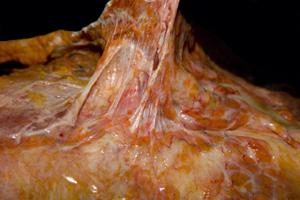Scar Tissue
Previous Injuries Add To Your Pain
Scar tissue is like a massive adhesion. It usually forms as the result of an impact injury, or, more commonly, from surgery or other cutting of the fascial network. Since fascia is the main substance that transmits movement through the body, the act of cutting the fascia, even via the most careful of incisions, creates definite stress to the fascial matrix. The body senses this immediately and in an attempt to knit the fascia back together, its fibers glue back together in a very random fashion. This randomness is what is called scar tissue.

Thickened and Stuck Fascia = Scar Tissue
Fascia is found in numerous layers of varying thickness throughout the body. When cut and then stitched back together again, the normal alignment of the various layers of fascia can never again be perfectly matched. So the movement information that is transmitted through that area of fascia is forever disturbed.
The stress of this disarray eventually leads to the formation of additional adhesions, spreading the effect of the scar tissue to a much broader area. Eventually, even structures far from the original site of the cut or injured fascia begin to show the effects of this strain. Symptoms begin to crop up that do not seem related to the original tissue injury, often leading to confusing conclusions and missed diagnoses.
Some forms of bodywork, like Structural Integration, can help restore some semblance of organization to fascia that has been cut, but it can never be brought back to its original state. This is why every surgery should be carefully weighed, benefits vs. drawbacks.
When there is a hard impact injury, such as being thrown from a car and landing with a hard impact, the fascia records the effects the impact has on the body. The fascia seizes up in reaction to the trauma. In many cases this holding pattern releases on its own with time. But for some people, the trauma response is so powerful the tissue doesn't let go. Over time, the fascia becomes glued in a bunch, acting like scar tissue. Structural Integration can be very helpful for releasing this type of scar tissue.
What Effect Does Scar Tissue Have On The Body?
Imagine that the fascia in your body is like a big knitted sweater. It can easily stretch in all directions. If the yarn is pulled (as in a snag), the normal orientation of the threads are disturbed, shortened, and can no longer move freely. If you pull on the sweater through the snagged area, the sweater can no longer stretch as it did before. It is limited in its range of motion and areas far from the site of the snag are also affected in their movement.
The same thing happens in the human body when scar tissue forms. Tissue that used to be able to stretch and flex easily now becomes tight and restricted, with limited range of motion. The resulting pull affects everything throughout the body that is even remotely connected to that tissue.
The Effect Of Deep Scar Tissue
When there is a deep trauma or deep cut to the fascia of the body, not only is the fascia running through that area affected, but also the deep fascia that suspends organs can also be affected. The fascia that suspends organs tends to be connected to the deepest areas of the body, making detection or correction of any part of that scar tissue challenging.
There are techniques which can bring some relief and restoration of balance to these types of deep tissue injury. Look for practitioners skilled in Structural Integration, Cranio-Sacral Therapy, or Visceral Manipulation. Contact information for these modalities can be found in the "Resources" section.
Also visit these related pages:
Fascia - What You Don't Know Is Hurting You
Adhesions - The Real Source of Your Injury
Fascia Anatomy - Understanding Your Opponent
Stretching Fascia - The Ultimate Injury Solution
Click the block below that most closely matches your injury for more information and to find the Toolkit we offer to help you in your recovery.







